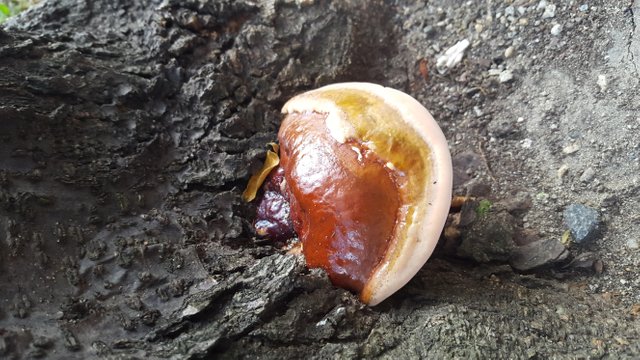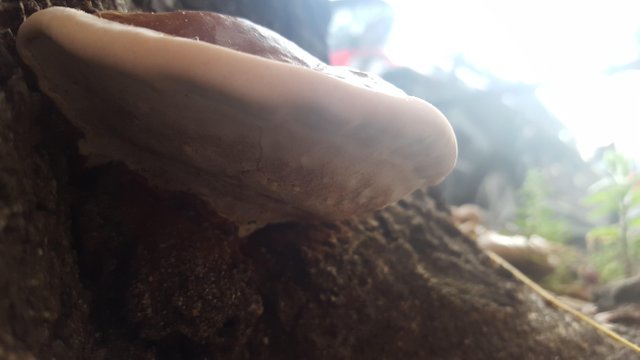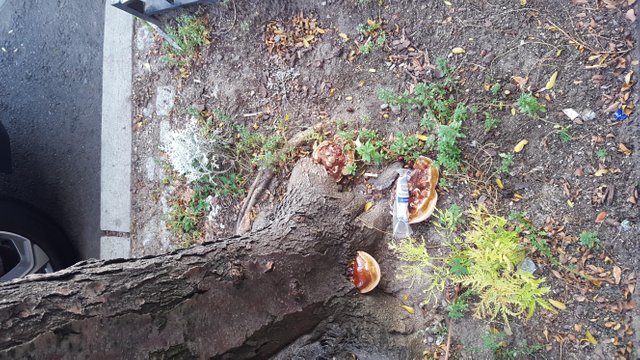The Amateur Mycologist - Random Finds - Ganoderma ("Reishi") Species - A Pretty Discovery/Urban Tree Blight
These posts are not for foraging. They are intended for entertainment and intellectual satisfaction only. These posts are not a field guide nor comprehensive in any way - their accuracy is not assured in any way. Do not eat wild mushrooms unless you are a professional, have substantial professional assistance or have a wealth of personal experience with a specific species. Do not make any foraging decisions based on these posts. To do so could be dangerous or life threatening.
These Posts Contains No Information Regarding Edibility Or Toxicity

Some mushrooms are less obscure than others
Many of the mushrooms I've talked about so far are unknown to most people. But some mushrooms have made it into the zeitgeist in a serious way. The Reishi mushroom might be foremost among them.
"Reishi" is a nickname for what turns out to be several species in the "Ganoderma" genus. As always, before DNA analysis, several species were mistakenly lumped together as Ganoderma lucidum. However, it turns out that what once was a single species is actually several.
Nonetheless, there are certain macroscopic traits which most Ganoderma or "Reishi-like" mushrooms share and which allows me to confidently place this mushroom within the genus:
- They tend to be brown, with lighter yellow and oranges when young, getting darker into a crimson brown in old age.
- They are polypores with a whitish base that discolors darker with age - see the picture below - sorry for the quality.
- Their caps have a shiny "varnished" look to them, at least in the developed, brown portions.
- They tend to grow at the base of hard wood trees, either alone or in small groups, usually as shelves.
Take a look at the underside - again sorry for the poor quality - I was out getting something from the store and in a rush.

It's a bit hard to see but the pore surface near the egdof the cap, the newest growth, is an off white, while the pore surface closer to the older portion of the mushroom is beginning to discolor.
Based on the coloration, varnish, cap structure, pore surface and location on the tree, I can confidently say this is a Ganoderma species. Importantly, I could be wrong - and I cannot say for certain which specific species this is.
Conventionally, Reishi has come to refer to G.lucidum and G.tsugae, both of which are nearly identical macroscopically.
If I had to guess, I would say this mushroom is G.sessile.
G.sessile is a Ganoderma species specific to the Eastern US. It's name, sessile, means "fixed in one place or immobile", and is a testament to one important characteristic, G.sessile has little or no stem.
Given my location, the prevalence of this species here and the lack of a stem, I believe this is a fair guess. Of course, I hate guessing - but sometimes that's all you have time to do.
Reishi mushrooms have a widespread reputation on the internet, and a burgdeoning source of interest in medical and scientific circles. I'll leave it to the interested reader to do their own research and come to there own conclusions.
But two takeaways from this:
This poor public tree is likely in bad shape internally. The presence of G.serrile does not bode well for the tree's health.
Urban mushrooms, especially on thoroughfares, are just gross. Take a look at the photo below and consider the number of dogs, squirrels and rats that have nibbled or pissed all over those things.

Still a cool find - and actually fairly common in urban environments.
Keep your eyes peeled while walking around the city in summer and you're likely to see some yourself. Just keep an eye up as well for the falling limbs of a dying tree. :/
Support the SteemSTEM initiative - curating and supporting quality STEM related content on Steemit.
Information sources
[1]Michael Kuo on G.lucidum
[2]G.sessile wiki page
[3]Tree care industrymagazine April 2017
Interesting side note, for many parisitic and saprobic mushroom species that live on wood, tree care specialists are often as knowledgeable, for practical purposes, as mycologists. It makes sense as these mushrooms eat the trees they care for.
[4]Memorial Sloan Kettering Synopsis On Reishi Applications And Medical Research
Photos are my own..
.
.
Really good article!
I would add that many polypores (including these Ganoderma spp. I believe) are perennials and even if you don't see them, there's usually molds and algae growing on them.
Another reason not to eat wild mushrooms without proper preparation.
Thanks! And seconded regarding the hidden dangers of urban yuckiness :).
For those interested in quality mushroom related products from a reputable reseller- check out Fungi Perfecti. Paul Stamets is very well known in the mycological community and this website is about as sure a thing as you're going to get. It's also a relatively safe way to satisfy any incipient mycological cravings.
Gary Lincoff was telling us they're actually an invasive species in NYC. If I recall correctly, being saprotrophic, they also work their way into the root system of trees and eventually cut off the tree's nutrient supply network. There are apparently many trees around the city where you can find them growing near the bases, and it generally doesn't bode well for the tree long-term.
Absolutely - I linked to an article from a tree care trade paper - they
resteemin this! awesome
Nice find! We have Ganoderma applanatum down here in Tasmania.
I never get tired of hearing about how distant mushrooms in the same genus have made it around the globe.
Ive recently picked up this hobby too.
Identification can be tricky to say the least.
It's a great deal of fun - you would enjoy my series very much I think - nothing revolutionary , but a lot of fun. Actually there's a good amount of mushroom and mycology content on steemit, especially mixed in with the general nature content.
I actually just completed my first spore print today.

No idea what kind of mushroom left this print, but, Ill try and figure it out.
Congrats! You're on the right track.
Taking spore prints is a basic step for mushroom identification.
Awesome! This is a very nice print - if you have more information about the original mushroom, some pictures and whatnot, we can make a stab at it!
Unfortunately, although a spore print can be the dispositive element in making an identification, it is not possible to reverse engineer an ID from a spore print alone. :)
I literally just found some immature reishi the other day. I was planning on doing a post. I should probably include some kind of disclaimer, as you do. Great pictures! I can tell how glossy they must have been!
I used to make all of my disclaimers sort of implicit and scattered them unofficially throughout the posts. I still think that was sufficient in a legal sense - but after seeing some reckless behavior regarding mushrooms in some other posts, I felt it was a moral prerogative to absolutely unequivocal about it.
Personally, I'm a bit of an anxious person, and no matter what knowledge I gather, I can't bring myself to eat my finds anyway. But my posts here, although I try to make them information dense and accurate, are anything but authoritative.
So, long and short of it, I'm a big believer in the disclaimer. But I also believe in increasing knowledge, and fungi are these awesome things that surround us all the time, which makes them the perfect candidates for pop-education like this.
Thank you for sharing this great article on this mushroom. I resteemed it ;)
Thanks for reading - this is actually a truncated version of the normal, more comprehensive species posts. But now and again you stumble upon a mushroom on the way to the supermarket... and here we are :)
This post received a 3% upvote from @randowhale thanks to @dber! For more information, click here!